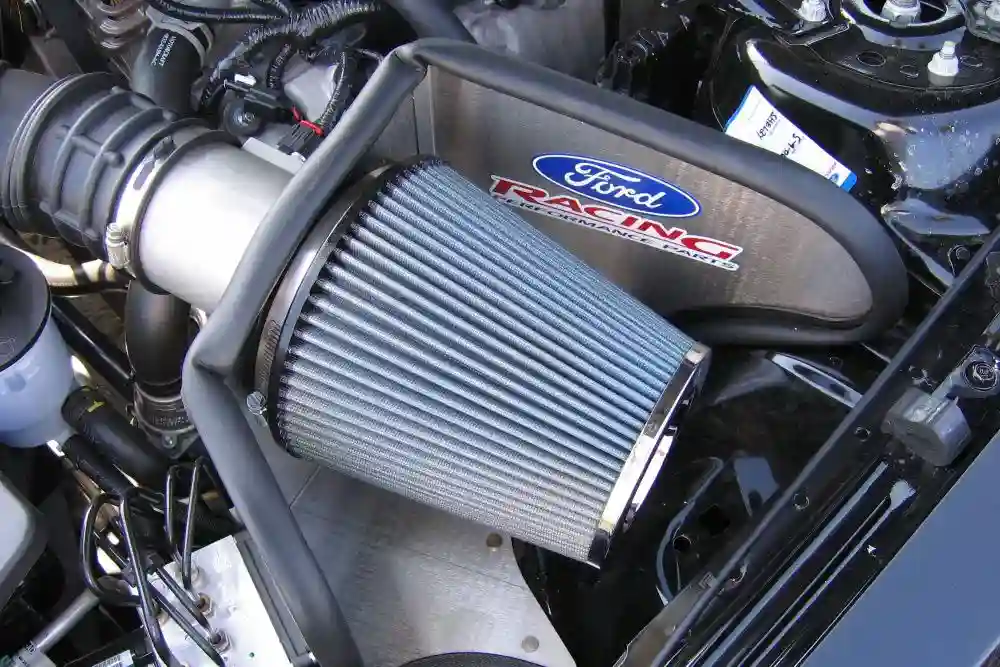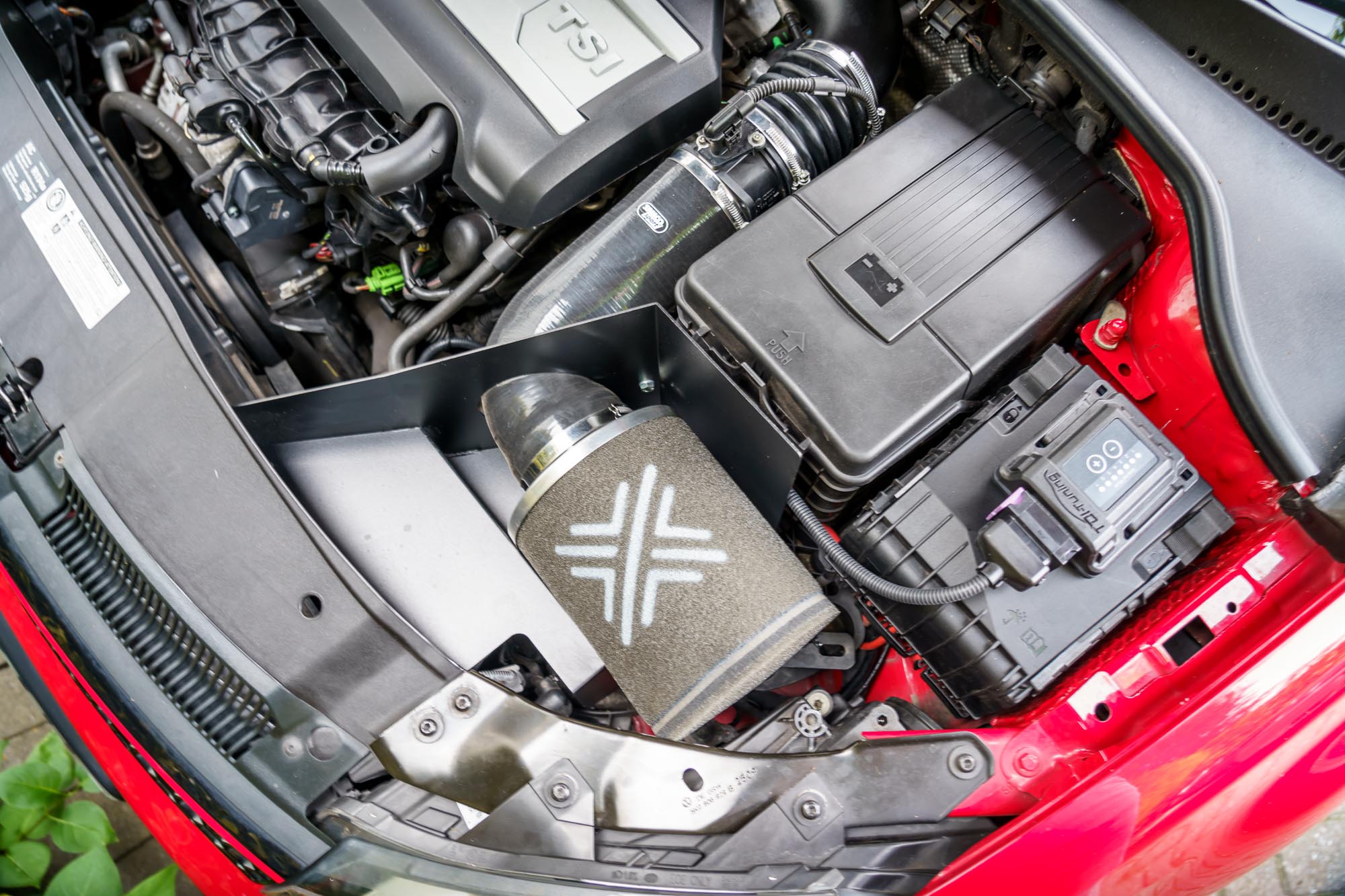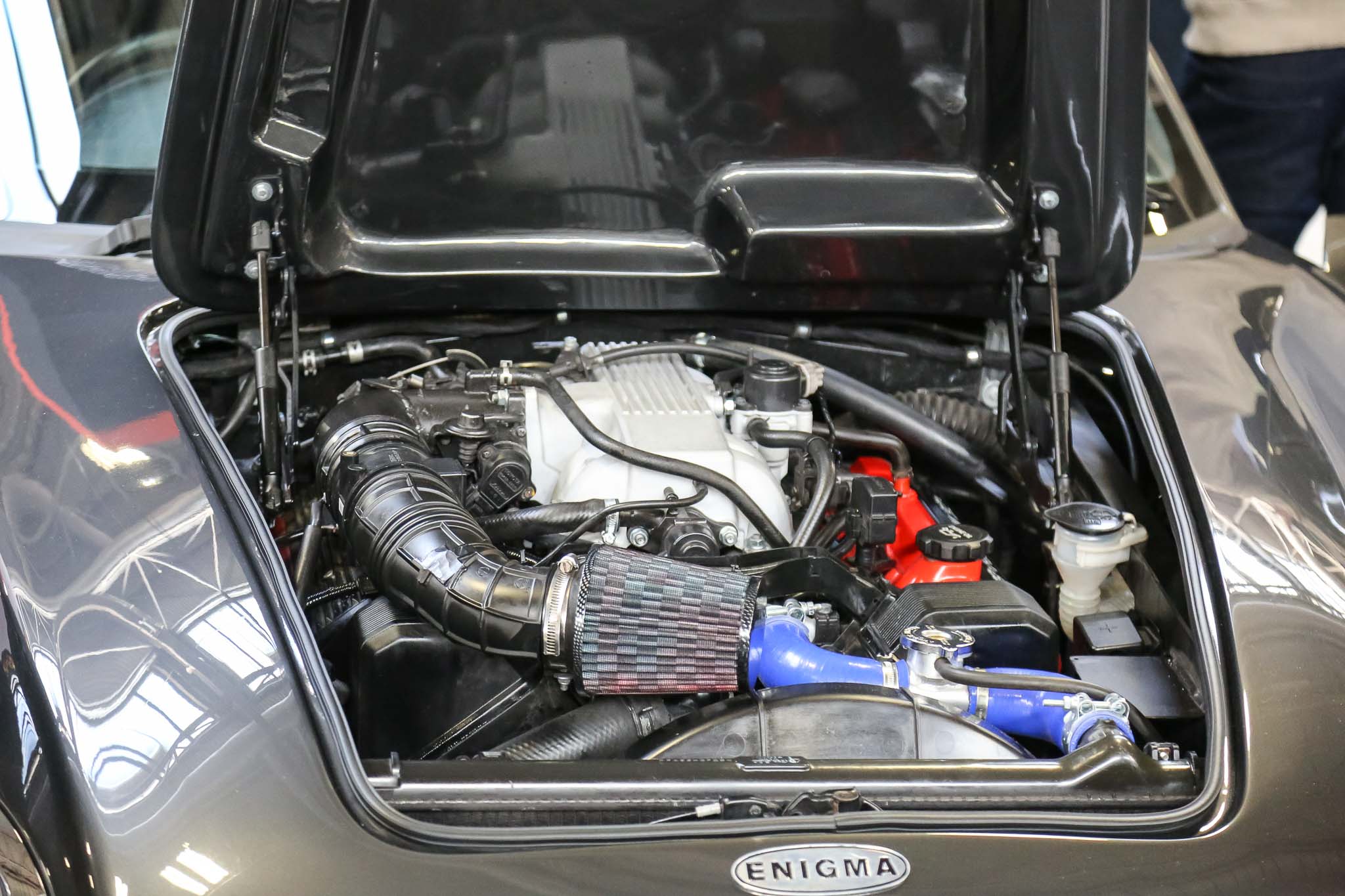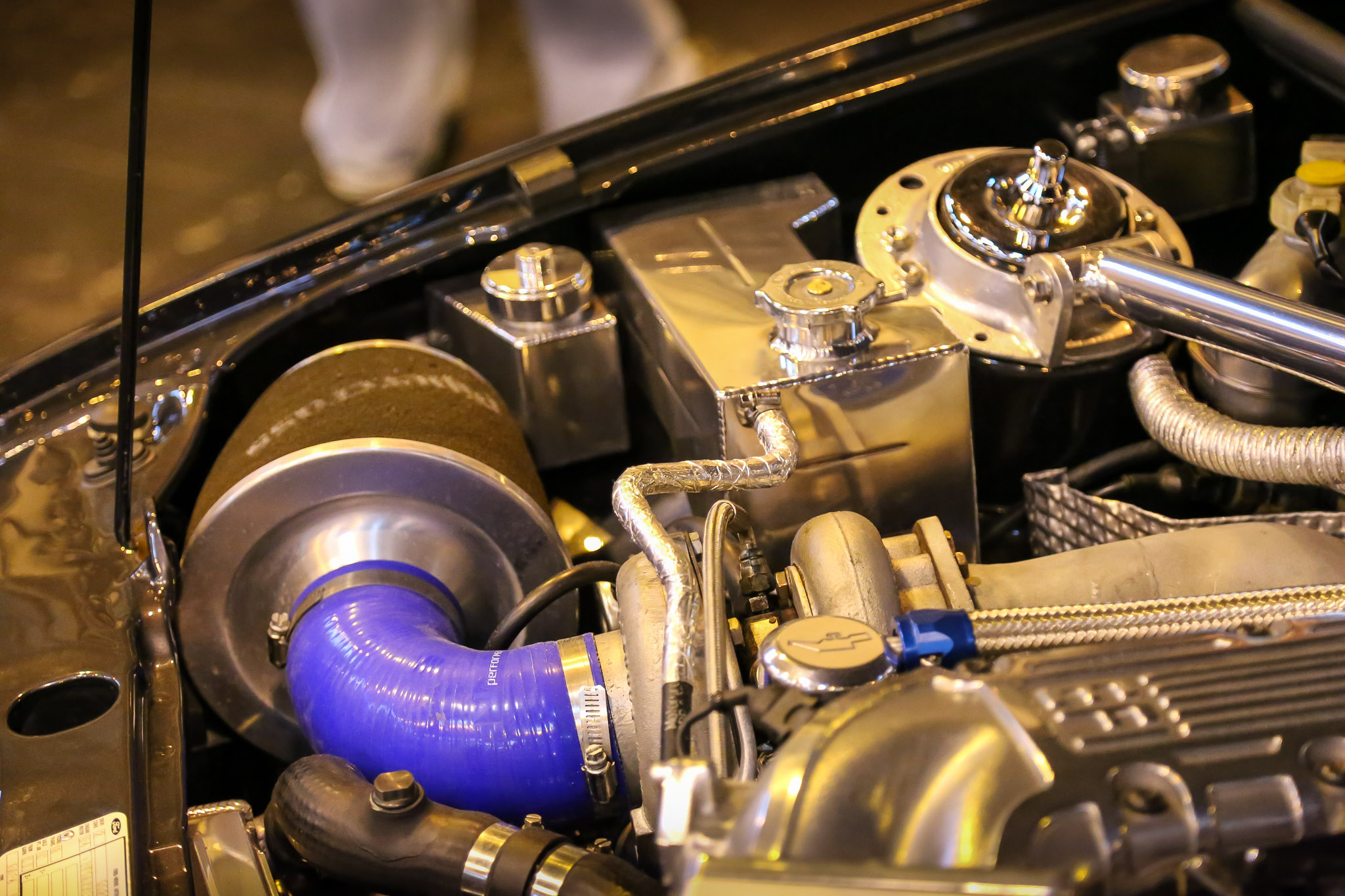Upgraded tires and suspension bits will surely improve your car’s handling. But that’s not enough these days, leading you to think about what does a cold air intake do. The never-ending quest of making your automobile more “powerful” has prompted people to create some of the best aftermarket systems. Starting from new exhausts to fitting turbo and superchargers, the list of improvements you can make to a car’s engine is excitingly long.
Now, although there are a plethora of components to make your car a beast on the street, it costs money and time. If your goal is just straight-line, pure speed, the engine has to be tuned first. A common primary step in this direction is installing a cold-air intake. Fairly inexpensive in comparison to its contemporaries, a cold air intake is much easier to install as well.
Before getting into a more in-depth discussion, it’s important to note that a cold air intake won’t add as much power to the engine as other modifications, but it will surely improve the quality of the engine. This modification brings the air filter outside the engine compartment to allow the engine to suck up more cool air for combustion.
Here’s a real-life example to help you understand better. When you have a cold, it blocks your nose and restricts breathing. You can’t expect to feel better after taking a jog. If a factory air intake system is that cold clogging up your brain, a cold air intake is a life-saving medicine that will let your engine breathe.
- Factory Air Intake Systems
- What Do Air Intakes Do?
- Parts Of An Air Intake
- What Are Cold Air Intakes?
- Benefits Of A Cold Air Intake
- Repairs & Troubleshooting
- Maintenance & Servicing
- Are Cold Air Intakes Worth It?
- Replacement & Installation
- Installation Costs
- Frequently Asked Questions (FAQs)
Air Intake
A few ingredients are required in an internal combustion engine to create the combustible energy an engine needs to turn the wheels of a car. Oxygen, fuel, and a spark combine to make the engine go.
Since our atmosphere contains plenty of nitrogen and oxygen already, all we need to do is trigger a chain reaction. When the air and fuel mix together and are exposed to a spark, magic happens.
This air is provided by car air intake systems that deliver it to the engine. A fully functional air intake system lets airflow enter the engine continuously, offering greater performance, consistent mileage, and power for the vehicle.
What Does An Air Intake Do
Air intake systems basically collect air from outside the car and bring it to the engine’s intake manifold inside. This is where it’s further combined with fuel acquired from the gas tank.
The fuel/air blend is ignited and transmitted across to the engine cylinders of the vehicle to start the explosive action needed for a car. It’s then transformed into physical energy, ultimately allowing the car’s wheels to turn once the power is moderated by the transmission.
Had it not been for air intake systems, automobiles wouldn’t be able to function on continuous internal combustion reactions. The sporadically produced motion would be rendered useless.
Engine Air Intake Parts
An operational air intake system consists of three main components. We will break them down one by one so it’s easier for you to grasp how these necessary parts work in harmony to engage the accelerator and turn the wheels of your vehicle.
1. Air Filter
The first main component of a typical air intake system, an air filter, is a plastic or metallic box containing a dedicated filtration screen. It can be found in front of the intake manifold of the throttle’s valve assembly.
To locate it, pop the car’s hood and find the boxy compartment beside the throttle valve assembly. The shape and make are very similar to that of commercial filters used in vacuum cleaners.
As you could probably decode from the name, air filters filter dirt and debris from the air. It stops contaminants from polluting the air intake system and damaging the engine. In addition, “pure” oxygen produces better engine performance because the final combustion reaction is more powerful.
2. Mass Flow Sensor
While the air filter allows air to enter the engine, the mass flow sensor detects how much air is entering the system. The right amount of energy required to drive a car can only be gained from a balanced internal combustion reaction. Modern automotive engines feature two kinds of mass airflow sensors: hot wires and vane meters.
Vane meters come with flaps that get pushed by air incoming from the filter tube. The more air that passes through the system, the farther the flap is pushed back. Meter is the unit used to measure the flap movement, and it estimates the amount of air flowing into the car’s engine at any given time.
Similar in nature to vane meters, hot wires sensors use a collection of wires. With every degree rise in temperature, the electrical resistance of the wires increases, starting a current reaction. In the meantime, it can measure approximate mass and airspeed.
3. Throttle Body
Last but not least, the throttle body of an air intake system regulates the air flow mentioned above. These components are characterized by bored or hollow housings that house a throttle plate turning on a shaft.
When you press the accelerator, the throttle plate opens, allowing air to enter the engine. On the other hand, upon release of the accelerator, the airflow is stopped as the throttle plate closes.
Thus, due to the lack of air reaching the combustion chamber, the chain reaction is stopped. This is how the throttle body handles the combustion rate as well as the car’s speed.
Cold Air Intake
Cold air intake systems are simply advanced variants of the regular system mentioned above. These systems bring in cool air into the combustion chamber and engine and therefore, help to improve efficiency and engine power. Now, this might bring you to question what’s the mechanism behind this process.
Colder air boasts a higher oxygen density. A certain volume of cold air has more oxygen than the same volume of warm air. So, the final combustion reaction is more productive, giving greater mileage alongside improved engine power.
Aside from reducing the air temperature, a cold air intake increases airflow too. With an aftermarket intake, the box around the air filter can be removed and large-diameter intake tubes are used.
Those are smoother, wider, and don’t have as many bends. Taking the airbox out of the equation and using smoother tubes offers uninterrupted airflow to the engine. Essentially, a cold air intake maintains a cooler temperature outside in comparison to the engine environment, necessitating better combustion reactions.
Cold Air Intake Benefits
Professionals and automobile mechanics often suggest that owners get a cold air intake system installed in their cars. If your vehicle is a newer model, it can surely benefit from this modification. Below are some of the advantages of getting a cold air intake for your vehicle:
1. Increased Horsepower
We mentioned before the one factor that decides the output power of an engine – the amount of air consumed in the combustion process. Cold air lets fuel burn more efficiently than warm air, so automatically, the oxygen combustion rate is improved. Because of this, adding a cold air intake to your car can give increased horsepower.
The amount of horsepower delivered depends on the particular vehicle configuration since setting up a cold air intake might add about 5 to 20 extra HP.
2. Improved Acceleration
The benefits of having a cold air intake can be felt every time your feet touch the accelerator pedal. This modification can increase the responsiveness of the vehicle.
The reason behind this reaction is the intensity with which the car reaches the target speed – it’s much faster when a bigger volume of cold air is taken to the combustion chamber. If you love a punchy and solid acceleration, installing a cold air intake could do you good.
3. Improved MPG
We talked about how cold air intake improves a vehicle’s gas mileage. With the correct volume of oxygen delivered through the engine, the internal combustion engine produces more “power”.
The deficiency of oxygen increases fuel consumption so this is where having a cold air intake could come in handy. Thanks to this system, the optimum air-to-fuel ratio is maintained, which enhances fuel economy alongside some horsepower gains.
Needless to say, MPG efficiency and cold air intake are interlinked. One more benefit of a cold air intake is reduced gas expenses.
4. Enhanced Engine Roar
Well, if you love the booming sound of an engine, it’s going to do a whole lot more for you.
A factory air intake system, by its very nature, works silently. In contrast, a cold air intake is designed to offer greater performance. As more air is sucked in through the system, the intense airflow results in a much more gruff growl. Many car enthusiasts absolutely love this sound.
5. Lesser Expenses On Filters
Generally, factory intake systems are furnished with paper air filters. These have to be changed every 15,000 miles. However, aftermarket cold intakes come with easy-to-clean air filters that need replacement after gaining 30,000 to 40,000 miles.
Not only is it more cost-efficient, but it’s also easy and fast. All you have to do is run it through soapy water before giving it a thorough rinse in cold water. No skills or special tools are required!
6. Longer Lifespan of the Engine
Engines adore cooler air. As you might already know, heat is a primary enemy of engine components. When the engine consistently operates at higher temperatures, the risk of wear and tear on the internal components increases. A cold air intake system ensures that the engine remains cool, especially during strenuous activities. Consequently, this elongates the life of your engine, keeping those repair bills at bay.
7. Environmentally Friendly
Let’s talk green! A cold air intake might seem like a small upgrade, but it contributes to a greener environment. How? A better air-to-fuel ratio and improved combustion efficiency reduce harmful emissions. So, while you’re boosting your vehicle’s performance, you’re also doing your bit for the planet.
8. Boost in Torque
Torque is the twisting force that gets the wheels moving. An increase in torque leads to a more immediate response when you start to drive. Since a cold air intake improves the oxygen intake during combustion, it naturally enhances the torque. This boost might be especially noticeable during low to mid-range RPMs.
9. Value Addition to Your Vehicle
Thinking about resale value? Upgrades like a cold air intake can make your vehicle more appealing to potential buyers. Enthusiasts often search for vehicles with performance enhancements. So, if you ever decide to sell, this upgrade might just fetch you a better price.
10. Enhanced Throttle Response
A noticeable benefit, especially for those who drive aggressively, is the improved throttle response. With more cold air in the mix, the throttle responds more quickly, giving the driver a swift reaction time, especially crucial during overtaking maneuvers or spirited drives on winding roads.
11. Keeping Contaminants Out
Cold air intake systems come with high-quality filters designed to block contaminants more effectively than standard filters. These contaminants, like dust and debris, can damage the engine over time. With a more efficient filtering process, your engine remains cleaner and runs more smoothly.
12. Cooler Engine Bay
Many original intake systems draw air from the engine bay, which tends to be hotter. Cold air intakes, on the other hand, often pull air from outside the engine bay. This results in not only cooler air for combustion but also helps maintain a cooler engine bay, which can benefit other components situated there.
Making the switch to a cold air intake system can seem like a simple upgrade. Yet, the ripple effect it creates in terms of performance, efficiency, and even environmental benefits can be profound. However, before making any modifications, always consider the make and model of your vehicle and consult with automotive experts to ensure compatibility and optimal results.
Are Cold Air Intakes Bad
Now that you’re aware of all the benefits of a cold air intake, you also have to know when is the right time to replace it. You shouldn’t spend on a system that’s not working fine, so you must be familiar with the signs of normal operation. These are the tell-tale signs of a malfunctioning cold air intake.
1. Reduced Engine Performance
Perhaps the most common indicator of a bad cold air intake. As the cold air intake features the use of an engine air filter, the engine naturally loses performance when it’s clogged or dirty. This, ultimately, decreases fuel efficiency, power, and acceleration. In more severe cases, a clogged air filter had led to ignition issues – the car won’t start at all.
2. Illuminated Check Engine Light
If your Check Engine Light is constantly lit but you’re not sure what’s wrong after a regular checkup, it might have something to do with the cold air intake. Any problem in one of the installed sensors could set off the CEL to let you know there’s an issue.
There are numerous reasons behind an illuminated Check Engine Light but the most frequently seen ones are either faulty sensors or vacuum leaks. In simpler terms, the cold air intake is an induction system meant to transfer cold air to the car’s engine, so it definitely has a huge role in the functionality.
3. Surging Idle
A ridiculously high idle could possibly mean a faulty cold air intake system. In addition, it may be a sign of a vacuum leak. Many cold air intake systems are equipped with vacuum ports to house the vacuum routine of the original manufacturer.
When a hose on the vacuum ports comes loose or breaks, or if the ports snap entirely, this can lead to a vacuum leak. Ultimately, the idle is excessively high. Here’s how you can fix that.
Cold Air Intake Maintenance
Although cold air intake kits are powerful modifications, these are surprisingly low maintenance. Despite the incredible quality, a system like this doesn’t require much money, time, or work to stay strong.
- Gather enough knowledge about cleaning a cold air intake. This includes necessary cleaning intervals, the amount of oil to be used, the process of cleaning, bits to stay away from, and more. Some manufacturers are careful about including certain specifications, but a rule of thumb dictates that 30,000 miles are good enough. That is only applicable if you don’t spend too much time driving on dusty, rough terrains. A lifestyle like that will require more regular checkups of your vehicle.
- Hold the filter up to a light source and inspect it. There shouldn’t be any obvious holes and it shouldn’t be transparent either. If you see an air gap, know that your filter needs to be replaced. Alternatively, check if you can make fixes to the filter media – in an attempt to retrieve the original surface area.
- A good cleaning technique comprises oiling, drying, using compressed air, and bending pleats in order to remove dust and dirt from the filter. You may need to repeat the process if there’s too much debris to deal with. A nylon bristle brush is fine, but don’t take a metal brush to it as it could tear the pleats and filter media. This video could be helpful.
- Inspect the tubing and clamps to make sure the routing is correct and stop rubbing. The clamps could be loose enough for you to make small adjustments if ever needed, then tighten each one systematically.
- Lastly, you can hydro-shield and pre-filters to enhance the service interval alongside reducing the chances of hydro-locking and maintenance.
Is A Cold Air Intake Worth It
In theory, delivering more cold air to the engine does sound great but it doesn’t receive fruition till you put it to the test. The true increase in fuel economy and horsepower could differ from one car to another but one thing is certain – a cold air intake will surely improve the performance of your vehicle.
Once installed, a cold air intake system shows the difference instantly. There will be a natural boost in power after the throttle is entirely open. Some manufacturers claim that a cold air intake can add up to around 20 HP, as we noted before. Combine this with a new exhaust and your engine will run laps like never before. Plus, it increases system efficiency.
At the end of the day, a cold air intake is one of the many things you can add to your car to boost engine performance, so it will deliver on the promise. That being said, installing a cold air intake system comes with its own set of drawbacks.
Cold Air Intake Pros And Cons
What is it that a cold air intake does that could be the exact opposite of what you wanted from this modification? Not much, but there are a few scenarios. For example, if the air filter is exposed to such an extent that it starts sucking up water, the water will go straight to the engine. A bypass valve can be added to prevent this issue.
One more disadvantage is that it could nullify the manufacturer’s engine warranty on some of the newer vehicles. Make sure to thoroughly check your owner’s manual and warranty card before installing this system. These two aside, the old air intake only offers a smoother, more enjoyable driving experience.
As you zoom across the asphalt, the magnificent booming sound of the cold air intake system rings in your ears. The few additional horsepower really do wonders for the engine.
Replacement Cold Air Intake Filter
Cold air intake kits are available in multiple build options – plastic, metal, rubber, or composite. For the most efficient pick, get one that uses an airbox the same size as the engine and extends its powerband. The intake’s air opening should be big enough to let in an adequate volume of air whether your vehicle is idling or in full throttle.
Air flowing through the cold intake gets denser and thus, colder. As the cold air intake directly influences the power of an engine, a clogged, dirty, or failing intake system will decrease engine performance and fuel economy.
Over the years and regular usage, the filter in these intakes will get clogged due to the continuous air passing. When a filter is too dirty, the engine’s horsepower takes a hit. At first, it’s only reduced, but if you keep the filter like that without cleaning and it gets clogged, that’s when the engine really starts to get slower. Apart from decreasing fuel efficiency, the lack of oxygen to burn reduces the engine’s power.
Fortunately, it takes years of usage before there is even a need to change it. But that doesn’t mean you should ignore the common signs that the intake is failing. We mentioned a handful of the most usual symptoms of a bad cold air intake. Sometimes you can get away with just a wash, however, a replacement isn’t that far away.
Generally, you don’t have to replace aftermarket filters since they feature reusable air filters. Factory air intake systems, on the other hand, are disappointing with their paper air filters.
Installing Cold Air Intake
If you’re planning on installing this modification after learning what a cold air intake does, great choice! It’s surely a good investment. Swapping your car’s generic intake system for a cold air intake system could set you back around $150 to $500, based on the system. However, this includes the labor costs of getting it replaced, so it’s not the highest of costs associated with car maintenance.
What Does A Cold Air Intake Do: In Conclusion…
With a cold air intake, you save on filters and gas over time, so the price is more than worth it. These little inexpensive modifications can be amazing investments for your car.
Frequently Asked Questions (FAQs)
If you’re still curious to learn more about cold air intakes, our FAQs here might help…
How Much Horsepower Does A Cold Air Intake Add
One of the most important factors that determine an engine’s potency is the formulation of air that’s consumed during an engine’s combustion process. Colder air allows fuel to burn much more effectively and efficiently than warmer or hotter air. Therefore, the addition of a cold air intake is able to improve the combustion rate of an engine. As such, installing it into your car is certainly able to add at least some horsepower. Depending on the vehicle in question and how the engine’s set up, the horsepower increase varies. But, it should add another 5 to 12 horsepower on average, or upward of 20 horsepower in a best-case scenario.
Does A Cold Air Intake Increase Horsepower
Yes, a cold air intake does aid in boosting horsepower. However, its effectiveness does vary from one vehicle to another. After all, you’re changing the sometimes restrictive stock air filters with one that enables colder air to flow into the engine. In effect, colder air allows fuel to burn more efficiently, hence improving the rate of combustion. Thus, you’ll most certainly see some horsepower boost, even if a little. If you install one on a typical 4-cylinder engine, you could see a boost of upward of 20hp. Meanwhile, a sportier and racier engine might see higher gains than that. So, it’s a small increase, but not bad for its relatively low cost.
Does A Cold Air Intake Increase MPG
Usually, modifying the air intake doesn’t make too much of a difference toward fuel economy gains. The same principle can somewhat be applied to cold air intakes. But depending on the engine that it’s fitted to, you could see pretty respectable improvements in MPGs. At the very best, you may be able to see increases of between 3 to 5 MPG. The reason is that colder air is denser and is packed with a greater volume of oxygen than hotter air. Therefore, it’ll enable fuel to burn more efficiently and ensures a far more optimal air-to-fuel ratio compared to most stock intakes. Thus, increasing your MPGs, even if just for a tiny bit.
How Much Are Cold Air Intakes
Relative to most other modifications that you could do to your car, a cold air intake is comparatively inexpensive. The more entry-level kits could be had for around $150. All the while, higher-spec cold air intakes that are more suited for high-performance cars might run you as high as $500. On average though, most of the good ones are selling with a $300 price tag or thereabouts. When you consider that it’s able to add upwards of 20hp and an additional 3-5mpg (not applicable all the time, as it’s also dependent on your vehicle), getting one fitted to your car might be worthwhile.
How To Install Cold Air Intake
Installing a cold air intake is relatively easy, and it’s one that you could do at home, too! First off, you’ll need to disconnect the battery… Not just for safety’s sake, but also to allow the ECU some time to re-learn the new air-to-fuel ratios. Now, loosen and detach the hose clamps on the stock air tubes by the throttle body. You can then remove the MAF sensor from the air intake tubes, as well. Finally, remove all the bolts holding the stock air box. You can now start fitting the new cold air intake. Begin by sliding the air filter onto the intake tube and the air box. Then, attach it accordingly to the throttle body and re-attach the MAF sensor.




